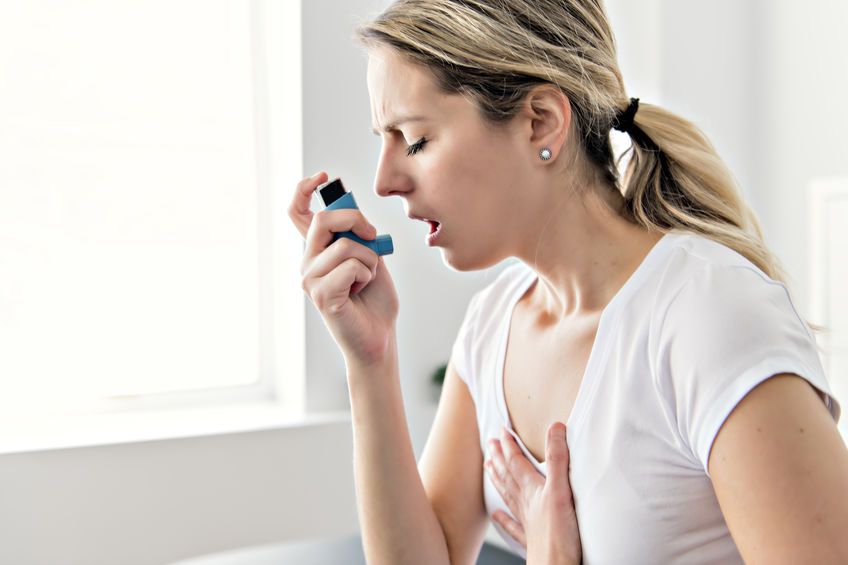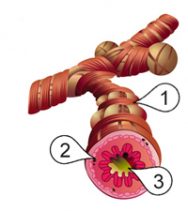When the body is at rest, quiet and regular breathing through the nose is sufficient. Breathing is inaudible and mainly with the use of the diaphragm. But that’s not what we see in asthma. Asthmatics breathe much more through their mouth, they sigh or snort regularly, breathe audibly and visibly at the top of the chest. And if an asthma attack occurs, the breathing frequency, wheezing and shortness of breath increase even further.

Breathing in asthma
In asthma, the airways are more sensitive to narrowing, which is due to a combination of three factors:
- Narrowing of smooth muscle tissue (around airways)
- Inflammatory reaction in the mucous membranes
- Increased secretion of mucus by the mucous membranes

Narrowed airways cause a feeling of shortness of breath and to compensate for this the asthmatic starts to breathe more heavily – faster and with larger breaths – and often through their mouth.
Research has shown that people with asthma breathe more air than people without asthma. While a healthy adult at rest breathes between 4 and 9 liters of air per minute, in people with asthma we see a volume of between 10 and 15 liters per minute.
‘However, breathing with high breathing frequency and volume does not solve the tightness of asthmatics. Overbreathing means that too much carbon dioxide is exhaled. One of the disadvantages of this is that the smooth muscle tissue can no longer relax properly. Thus, the narrowing of the respiratory tract remains intact. To prevent or recover from this effect, a bronchodilator is being prescribed as a medicine.
Overbreathing has another downside. The inner surface of the lungs is quite large. Stretched out flat, they would occupy an area of around 80 to 100 square meters. They are also continuously in contact with the outside air. So with overbreathing, the airways lose a lot of heat and moisture, resulting in coughing, wheezing and shortness of breath.
Effect of Buteyko on asthma
The Buteyko method offers various breathing exercises to be able to breath through the nose all the time, and to reduce the volume of breath to healthy proportions. Breathing ‘lighter’ means that carbon dioxide in the lungs and blood rises, which can reverse the disease process of asthma. Switching to lighter breathing through the nose ensures, among other things, maintenance of heat and moisture in the respiratory tract, which supports recovery of the mucous membrane.
Adults and children from the age of six can do the exercises, regardless of the severity of asthma. One of the first exercises is the ‘Nose opener’ to make a permanent switch to nasal breathing possible. We also tackle sighing with simple exercises, since even a regular sigh can maintain chronic overbreathing. To master a starting asthma attack you learn another exercise, so gradually you need the bronchodilator less and less, or no longer. Of course, adjustment of medication is always done in consultation with your doctor.
Our experience and various scientific studies show that applying Buteyko method can lead to:
- Improving own control of asthma symptoms
- Significant reduction in asthma symptoms
- Improving quality of life
- Up to 90% reduction of required bronchodilator
- Up to almost half less need for anti-inflammatory medication
Learning Buteyko
You can learn the Buteyko method in an individual course, with meetings live or online (by video calling), or with a combination of the two. At our office in Hoofddorp, the sessions will take place in compliance with all Corona measures.
For children and teenagers up to about 14 years there is a special program.
How is your breathing now?
Buteyko has developed a simple test: measuring the Control Pause. This test is explained here.
With children up to 13 to 14 years of age, we use a different measurement method; we count their ‘steps’. Please contact us if you want to try this at home.
Do you suffer from asthma?
Please feel free to contact us and request a free consultation. Or read more about out the content of the Buteyko course and how to sign up.
